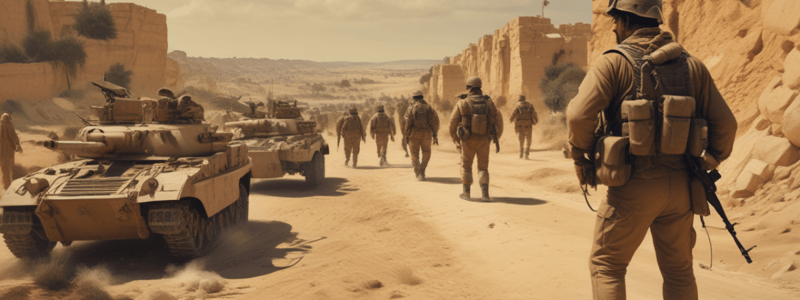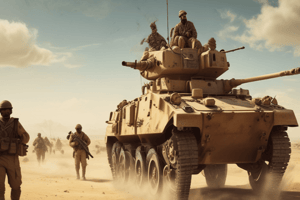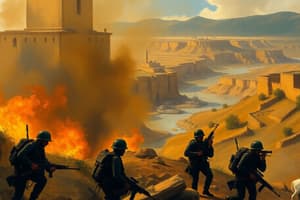Podcast
Questions and Answers
What was the date when four Arab states moved troops to Israel's borders, threatening the Jewish nation's existence?
What was the date when four Arab states moved troops to Israel's borders, threatening the Jewish nation's existence?
6 June 1967
Who was the President of Egypt who aimed at the destruction of the State of Israel and declared they would not accept any coexistence with Israel?
Who was the President of Egypt who aimed at the destruction of the State of Israel and declared they would not accept any coexistence with Israel?
Nasser
What did the state-controlled Cairo Radio announce on May 25, 1967, regarding Israel?
What did the state-controlled Cairo Radio announce on May 25, 1967, regarding Israel?
The Arab people firmly resolve to wipe Israel off the world map.
What was the outcome of the Israeli air force's strike on Egypt, Syria, and Jordan on the morning of 6th June 1967?
What was the outcome of the Israeli air force's strike on Egypt, Syria, and Jordan on the morning of 6th June 1967?
What did General Rabin write about his experience at the Kotel?
What did General Rabin write about his experience at the Kotel?
What was the symbolism behind Rabbi Shlomo Goren blowing the shofar at the Kotel?
What was the symbolism behind Rabbi Shlomo Goren blowing the shofar at the Kotel?
How did Israeli paratroopers feel upon reaching the Kotel?
How did Israeli paratroopers feel upon reaching the Kotel?
Why is Jerusalem often referred to as 'The city of Gold'?
Why is Jerusalem often referred to as 'The city of Gold'?
What inspired such strong emotions in Israelis after the reunification of Jerusalem?
What inspired such strong emotions in Israelis after the reunification of Jerusalem?
How did the victory in the Six-Day War impact national pride in Israel?
How did the victory in the Six-Day War impact national pride in Israel?
What resolution did Arab leaders sign in response to their defeat in the Six-Day War?
What resolution did Arab leaders sign in response to their defeat in the Six-Day War?
What territories did Israel absorb as a result of the Six-Day War?
What territories did Israel absorb as a result of the Six-Day War?
Which Arab countries initiated the Yom Kippur War?
Which Arab countries initiated the Yom Kippur War?
What significant support did Israel receive during the Yom Kippur War?
What significant support did Israel receive during the Yom Kippur War?
What was the outcome of the Yom Kippur War?
What was the outcome of the Yom Kippur War?
Flashcards are hidden until you start studying
Study Notes
The Six Day War
- June 6, 1967: Israel celebrates its 19th anniversary, but four Arab states (Syria, Iraq, Jordan, and Saudi Arabia) move troops to Israel's borders, threatening the Jewish nation's existence.
- State-controlled Cairo Radio announces: "The Arab people firmly resolve to wipe Israel off the world map."
- Israel is outnumbered and outgunned, with 800 tanks compared to 2,504 Arab tanks, and 300 combat aircraft versus 680 Arab bomber aircraft.
- Israeli Minister of Defence Moshe Dayan warns the government that the only chance of avoiding defeat is to strike first.
- June 6, 1967: Israel launches a preemptive strike, destroying over 400 warplanes on the ground, and rendering most Arab runways unusable.
- For six days, Israel fights on three fronts against Egypt, Syria, and Jordan, eventually capturing the Sinai Peninsula, Gaza Strip, West Bank, and East Jerusalem.
- June 10, 1967: A United Nations-brokered ceasefire takes effect, ending the Six Day War.
- Estimated casualties: 20,000 Arabs and 800 Israelis.
Battle for Jerusalem
- Jerusalem was a divided city, with concrete barriers and barbed wire separating it, and the Old City, including the Jewish quarter, under Jordanian rule.
- June 1967: Jordanian King Hussein joins the attack against Israel, despite Israel's promise not to attack East Jerusalem or the West Bank if he remained neutral.
- Israel encircles East Jerusalem from the north, eventually entering the Old City and advancing towards the Kotel.
- June 7, 1967: Israeli forces reach the Kotel, and General Rabin writes: "I was breathless... It seemed as though all the tears of centuries were striving to break out of the men crowded into that narrow alley."
- Jerusalem is reunited under Israeli rule, and Rabbi Shlomo Goren blows the Shofar, symbolizing redemption.
Legacy of the Six Day War
- The war led to a surge in national pride in Israel, but also fanned the flames of the Arab-Israeli conflict.
- Arab leaders sign a resolution in August 1967, promising "no peace, no recognition and no negotiation" with Israel.
- Israel absorbs over one million Palestinian Arabs, creating a refugee crisis that worsened an ongoing political turmoil and violence.
- The lands seized in the Six Day War remain a stumbling block in Arab-Israeli peace negotiations.
The Yom Kippur War
- October 6, 1973: Egypt and Syria initiate the Yom Kippur War, attacking Israel on the Jewish holy day of Yom Kippur.
- Israel is caught off guard, with many soldiers away from their posts observing Yom Kippur.
- Arab armies make impressive advances, but Israel eventually turns the tide with the help of US reinforcements.
- October 25, 1973: A ceasefire is secured by the United Nations.
Studying That Suits You
Use AI to generate personalized quizzes and flashcards to suit your learning preferences.




